The Women’s Bath was written by Ulfat al-Idlibi, a feminist born in Damascus. This short story depicts the existing conflicts of a family along the transition from the Syrian into the Arabic culture in three subsequent generations of women, the grandmother, the mother and the daughter.
The story takes place in two settings: the family house where the Arabic culture seems to limit women’s thoughts and wishes, and at the Public Bath, a place where women revive and reaffirm old traditions that have always been a way of making them feel beautiful and valued under the wishes of God. There, the old generations have their self-esteem strengthened while at home they are losing their space.
In this opportunity, the author uses the technics of description and imagery that takes the reader into a cultural moment that has been fading in time.

About the author
Ulfat al-Idilbi (1912–2007) was a prominent Syrian writer known for her vivid storytelling and focus on themes such as women’s lives, tradition, and social change. Born in Damascus into an intellectual and nationalist family, she began writing at a young age.
She became one of the first Syrian women to publish literary work. Her writing is deeply rooted in the cultural and political landscape of the Arab world, especially during the French Mandate and the post-independence period. Al-Idilbi’s stories often center on the roles and struggles of women in a patriarchal society, portrayed with empathy and insight.
In 1948, she was awarded a short story prize by the BBC Arabic Service, and her first story collection was published in 1954. Her most famous novel, Sabriya, was later adapted into a highly successful television series in Syria.
“The Women’s Bath” is among her most well-known stories, celebrated for its subtle critique of gender roles and its rich depiction of Damascene life.
